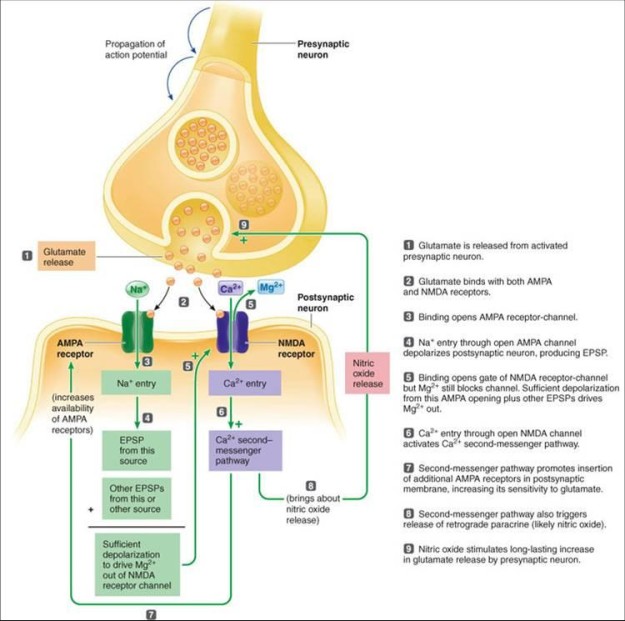What is Phenylpiracetam?
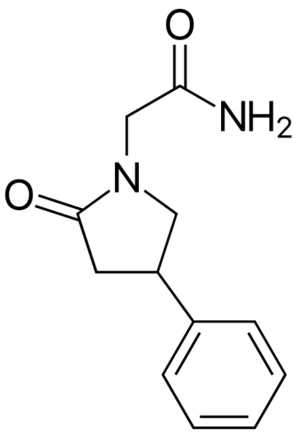
Phenylpiracetam is a powerful nootropic that's part of the racetam family found to boost cognition, motivation, and memory.
Phenylpiracetam, also known as Phenotropil and Carphedon, is a cognitive-enhancing nootropic similar in nature to piracetam, a member of the racetam family of compounds.[1] Phenylpiracetam was originally given to Russian astronauts to increase their mental capacity and cognition, and has become one of the most popular nootropics the past couple years.
Since its inception, phenylpiracetam has been used by those looking to enhance their mental capacity across a wide landscape. Nowhere is this more evident than in the work or study environment, where maintaining peak concentration and productivity is nearly impossible for an extended period of time. Whether it's due to mental fatigue, overstimulation (too much work), or boredom, the end result is the same – reduced output. To combat this, racetams were originally created in order to enhance the brain's abilities above and beyond what is normally attainable.[2]Note: If you are a drug-tested athlete, phenylpiracetam in on WADA's banned substance list.[3]
Phenylpiracetam vs piracetam
Many nootropic users have already studied piracetam, so it's great to compare and contrast the two.
The fundamental difference between phenylpiracetam and piracetam is the addition of the phenyl group, which makes it both similar to phenylethylamine (PEA) and piracetam; therefore, imbuing it with a few additional characteristics over that of regular piracetam.
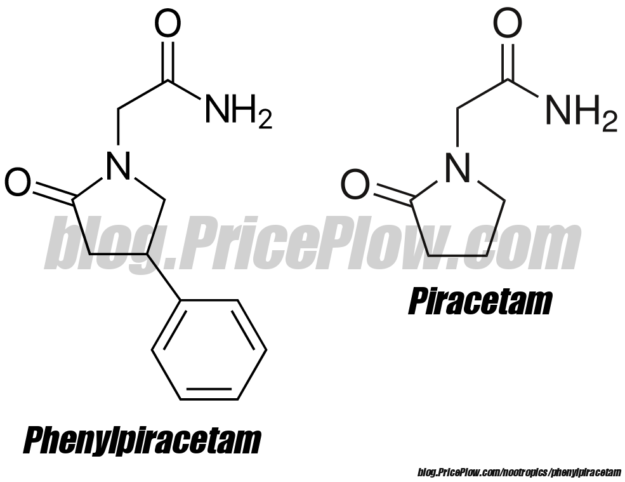
Phenylpiracetam vs Piracetam: Here you can compare the structural differences in the 2D molecules of Phenylpiracetam vs Piracetam
For this reason, we must warn you that you must never use this compound when on prescription drugs unless you have a doctor's written consent -- it cannot be combined with SSRI's or similar drugs. Also note that no statements on this page have been approved by the FDA.
Phenylpiracetam Benefits: the research at hand
While all of its effects have not been adequately studied, phenylpiracetam does have a few low-scale clinical studies showing its effects on various brain functions, including:
- Increased central nervous system stimulation[2]
- Improved memory uptake, storage and recall[2]
- Better motivation, attention and desire[4]
Now, it's time to get up close and personal with phenylpiracetam and see how it really work:
Increased CNS stimulation
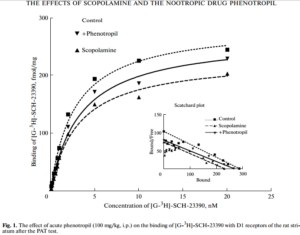
Acute administration of phenotropil (100 mg/kg, intraperitoneally) abolished the pathological scopolamine induced decrease in the density of the dopamine D1 receptor in the striatum.
- its structural relatedness to phenylethylamine (PEA), a neurotransmitter that improves motivation when taken as a supplement,
- its ability to increase dopamine receptor density[4], or
- its ability to bind to AMPA (α-amino-3-hydroxy-5-methyl-4-isoxazolepropionic acid) receptor,[2,4]
- or some combination of several of these.[2,4]
Relationship to PEA
Since phenylpiracetam has a phenyl group attached to it, similar to phenylethylamine (PEA), it's been suggested that it can bind to a group of trace amine associated receptors that are associated with psychostimulatory activity in the brain.[5] Furthermore, PEA increases the release of the norepinephrine and dopamine which together are thought to contribute to the wakefulness and stimulating properties of phenylpiracetam.[6] Note that the most powerful and popular stimulants on the market today have the common property of inducing dopamine release which increases wakefulness.[6]
Although dopamine's role in wakefulness isn't entirely understood, it is thought that its ability to bind to dopamine receptors in the striatum, an area of the brain responsible for arousal and stimulation, is the most likely mechanism.[7] Therefore, reduced dopamine signalling in this portion of the brain often results in a feeling of tiredness.[7]
Increase Dopamine Receptor Density
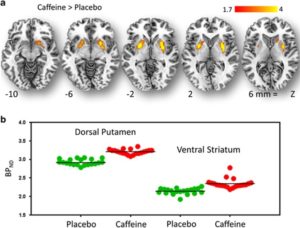
Caffeine D2 / D3 Receptor: This graphic shows caffeine's effects on wakefulness, it's through this same interaction with D2/D3 receptors that phenylpiracetam may also function as a stimulant.
One study suggests that phenylpiracetam is capable of increasing these receptor subtypes without actually binding to the receptors themselves.[4] As D1, D2, and D3 receptors are known to play a role in mediating wakefulness (shown through caffeine's ability to increase D2 and D3 receptor subtypes and through sleep deprivation role in decreasing D2 and D3 receptor subtypes [7]), then this pathway may also present a viable explanation as to how phenylpiracetam exerts its stimulatory properties.
It is unknown if these newly-created receptors stay permanently, but it could be theorized that phenylpiracetam has a positive medium-term effect even after it's not in use because of these improvements.
Binding to AMPA Receptors
The final pathway we'll explore is phenylpiracetam's ability to bind to AMPA receptors.[6] One of the main modes of action for racetams occurs via AMPAkine activity (named after the receptors in which they interact with) which is also thought to possess increased wakefulness properties.[8]
![AMPA Receptor: The AMPA receptors present a unique characteristic in the mechanisms of subunit regulation during LTP (long-term potentiation) and LTD (long-term depression), which are involved in the trafficking, altered composition and phosphorylation of AMPA receptor subunits.<sup>[24]</sup>](https://blog.priceplow.com/wp-content/uploads/ampa-receptor-300x292.png)
AMPA Receptor: The AMPA receptors present a unique characteristic in the mechanisms of subunit regulation during LTP (long-term potentiation) and LTD (long-term depression), which are involved in the trafficking, altered composition and phosphorylation of AMPA receptor subunits.[24]
A different kind of alertness...
Furthermore, this form of wakefulness is akin to the form you get whenever you sleep past your alarm clock and desperately need to get to work on time to avoid being late. If you've ever noticed that the startling transition from being in a deep slumber one second to full alertness the next in those situations, then that is what we're talking about. While other catecholamines are also at play in this situation, the feeling of such alertness produced is very similar to that of phenylpiracetam![6]
Increased learning, memory uptake, storage and recall
While learning and memory are not quite the same thing, they both rely on each other to function optimally.[10] Learning is the process in which we acquire new information, while memory is both a record of that process (learning) and of the new information.[11] Memory is then further complicated by the fact that it has several stages that occur between uptake and retrieval that must perform well in order to keep memory functionally optimally.
In other words, if a problem exists in any one step of this process, then your memory capability as a whole is severely compromised. The components of memory (uptake, storage and retrieval) characterise your ability to receive new information, store that information appropriately, and recall old information in that order.[11]
Phenylpiracetam's Role in Learning & Memory
Now, let's take a look at the way in which phenylpiracetam impacts both learning and memory:
- Appears to work primarily on glutamatergic receptors AMPA primarily, and through increasing NMDA density[2]
- Appears to act on the nicotinic cholinergic receptors[2]
- May stimulate the increase of dopamine and norepinephrine which work together to increase learning and memory[2,4]
Let's now take a look at these three components individually to see how they increase learning and memory.
Glutamatergic Receptors AMPA and Increasing NMDA Density
Glutamate receptors are an important component to the development of a type of memory storage known as long term potentiation (LTP).[10] LTP is a mechanism by which stable memories are formed and occurs when the synapse between two neurons is strengthened by repeated signalling.[11] This type of strengthening forms what is known as "synaptic plasticity", as it describes our brain's ability to change its structure to accommodate the accumulation of new information or the loss of old information.[10,11]
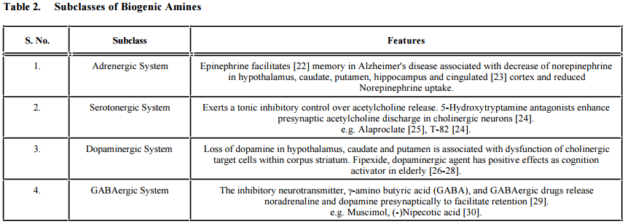
Biogenic Amines: Here's a graph breaking down the various biogenic amine subclasses that are frequently discussed.
Phenylpiracetam can induce LTP by binding to a group of glutamate receptors known as AMPA.[2,4] These receptors are vital in regulating synaptic plasticity and maintaining the excitability that leads to and sustains LTP, however they do not act alone.
The NMDA glutamate receptors play an equally critical role in stimulating LTP; however these receptors are normally blocked by a magnesium molecule at resting membrane potential and therefore cannot perform their normal duties until the magnesium is removed from the receptor.[11] Once piracetam activates the AMPA receptors, the neuron it binds to becomes depolarized and the magnesium blockage is removed from the NMDA receptors and the process of LTP starts.[10]
Sustaining LTP
This only explains how LTP begins but not how it is sustained. Whenever a memory is encoded, there needs to be some sort of semi-permanent change occurring within the nervous system in order to maintain that memory, and while NMDA receptors are important in inducing memories, they cannot sustain them. Here's where the AMPA receptors come back into play.
Once a neuron has had the process of LTP initiated, there is an increase in the number of AMPA receptor sites present on its surface which further allows for an increase in neuronal strengthening.[10,11] This semi-permanent structural change occurs once new proteins have been synthesized and are then able to change the shape of the original neuron, allowing for memories to be sustained long after the original stimulus has passed. The whole process is thought to be behind the primary reason why memories can be sustained for months or even years -- repeated neuronal stimulation and protein synthesis occurring within the brain [11]
Effects on Nicotinic Receptors
Nicotinic receptors have long been known to aid in the increase of memory formation. The mechanism in which this works is tied in with a signalling pathway that is required for the formation of contextual, spatial and working memory.[14,15,16] Contextual memory is used whenever you are trying to recall the circumstances of a specific memory where the recalled version is exactly the same as the memory that was initially encoded.[16]![Nicotinic Receptors: Figure 3.2: Nicotine binds to specific receptors on the presynaptic neuron. When nicotine binds to receptors at the cell body, it excites the neuron so that it fires more action potentials (electrical signals, represented by jagged shape in lower left of figure) that move toward the synapse, causing more dopamine release (not shown in figure). When nicotine binds to nicotine receptors at the nerve terminal (shown above), the amount of dopamine released in response to an action potential is increased.<sup>[25]</sup>](https://blog.priceplow.com/wp-content/uploads/fig3.2-300x200.gif)
Nicotinic Receptors: Figure 3.2: Nicotine binds to specific receptors on the presynaptic neuron. When nicotine binds to receptors at the cell body, it excites the neuron so that it fires more action potentials (electrical signals, represented by jagged shape in lower left of figure) that move toward the synapse, causing more dopamine release (not shown in figure). When nicotine binds to nicotine receptors at the nerve terminal (shown above), the amount of dopamine released in response to an action potential is increased.[25]
Real World Example
Often when people recall details of an event, their interpretation of the event and how it unfolded can be skewed as time passes and it is very common for their version of the story to end up being somewhat different from what actually occurred.[17,18] This contextual memory is often why eye witness accounts of crimes are vital in the hours after the crime occurred, as any longer and the actual recollection of what happened may become blurred or skewed by your imagination or other memories.[16,18]
As important as contextual memory is for recalling particular past events, maintaining the integrity of that information is equally important. In this case, phenylpiracetam may aid contextual memory so that you are better able to recall events that have occurred in your past with a greater degree of accuracy.[18]
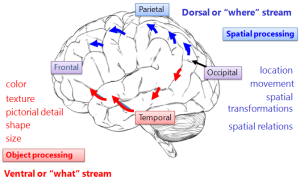
Spatial Memory: Areas of the brain dealing with spatial vs. object processing. Image courtesy Harvard Imagery Lab
In addition to contextual memory, phenylpiracetam's interactions with the nicotinic receptors also plays a role in the development of spatial memory.[15,16,17] Spatial memory is the form of memory you use when trying to navigate to a location in your city or manipulate objects and numbers in your head. Basically, spatial memory allows you to point in the right direction even when the endpoint is not visible from where you currently are.[15]
The last form of memory thought to be influenced through these receptors is working memory, which occurs alongside long term and short term memory.[16] Working memory is often used synonymously with short term memory; however, the two are fundamentally different in that working memory allows for the temporary storage and manipulation of information within the brain.[16,17]
In essence, working memory allows a person to solve a math problem in their head without paper, remember not to add the same ingredient twice when making a recipe or remember the context of an article after you finish reading the first opening sentence.
Other examples of working memory include reading an article or book and forming a picture in the mind about how components work together and when most of the pieces are positioned correctly. Working memory enable you to see the final picture and therefore understand how each component works.
Increased dopamine and norepinephrine for Greater Episodic Memory and LTP
The release of dopamine and norepinephrine play an important role in the development of episodic memory.[19] Episodic memory, also known as event memory, is an essential component of human behaviour established when dopamine neurons respond to punishment, reward, or goal-orientated behavior.[19,20] It allows us to reflect on past decisions in order to improve subsequent decisions and actions – thus demonstrating an importance for future decision making and our drive to accomplish new tasks and achieve new goals.
One key feature of episodic memory that seems to be modulated by the midbrain and hippocampus interactivity is representational flexibility or cognitive flexibility theory.[19,20] In essence, this form of learning is what allows us to solve problems that we've never encountered before by using associations with previous memories and reconstructing them to solve the problem at hand.
This is most prominently encountered in workplaces, schools, universities and everyday lives. Cognitive flexibility not only looks favorably upon us if we can solve issues as they arise, it can also reduce the amount of work and stress we accumulate if we can solve problems before they become a burden on our minds.[19,20]
With that in mind, dopamine and norepinephrine also plays other roles in forming new memories, most notably through the emotional charging of memories and through the creation of long term memories.[21] Emotionally charged memories are those that occur during moments of joy, anger and fear are far more memorable than those that occur under neutral emotive states.[21,22] This is primarily because norepinephrine is able to bind to adrenergic receptors which cause a rise in cAMP concentration and then PKA activation which increases long term potentiation.[21,22]
However, what is most interesting is that memories do not have to be emotionally charged in order to reap the benefits of this form of storage; the memories just need to occur after an increase of norepinephrine in order to "trick" the brain into forcing them into long term storage.[22]
Increased motivation
While the ability to enhance our memories and learning capabilities is an interesting concept, without the motivation to perform work, all this potential will go to waste. Here's where dopamine's role in motivation and reward comes into play.
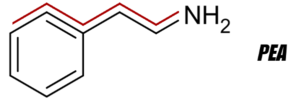
Here's the PEA 2D Structure Receptor with the PEA Backbone Highlighted. The good news is that it binds with the dopaminergic receptors for a quick mood boost. The bad news is that when used alone, it is metabolized too quickly .This is why it's great to bind to other compounds like piracetam!
In humans, the effect is almost identical: whenever a human possesses higher levels of dopamine in the mesolimbic pathway (motivation neural pathway) they work harder for things and remain on task for longer periods in order to achieve their goals. On the other side of the spectrum, those with lower dopamine levels typically slack off more often or take the shortest route possible to achieving the task and often to a much lower standard.[20]
What's the key phenylpiracetam dosage?
The typical dosage for phenylpiracetam is 100-200mg, taken up to 3 times per day for a maximum dosage of 600mg. The first dose is best taken prior to learning activities or periods where motivation and mental energy is required and then followed by 1 or 2 more doses once energy and motivation levels drop, known as the "3 P.M. lull at work."
Phenylpiracetam's stimulatory effects should be noticed from the first dose; however, its effects on learning (particularly long term memory) take time to exert their effects given they require structural changes in order to occur. So, don't expect miracles if you try this for the first time ahead of a major mid-term or semester final!
Tolerance Build Up
Tolerance is known to build with this racetam, and sometimes rather quickly. To prevent this from occurring, it's recommended that you cycle this regularly or save it for those periods of intense all-night work or cramming sessions ahead of a major project or test.
Many users prefer to only use it on weekdays, as tolerance can be built up in as little as four days for some. Monday through Thursday, with Friday through Sunday off is a popular cycle.
It should be noted that phenylpiracetam is not found in nature, so it is not DSHEA compliant as a "dietary supplement". Yet is also not a prescription drug in the US, so it is in a legal gray area. In some other countries, it is known as Carphedon.
Stacking Phenylpiracetam
Choline
Choline is an extremely popular and common nootropic for its ability to increase levels of the "learning transmitter" acetylcholine. The very best forms of Choline are Alpha GPC or CDP-Choline (Citicoline), due to the their excellent bioavailability in the body. Choline Bitartrate is another option that is cheaper, but not as bioavailable.
Phenylpiracetam is frequently stacked with choline to potentiate its effects and to ward off acetylcholine headaches, an occasional side effect of racetam use, due to depleted choline reserves.
Start with 250mg Citicoline or Alpha GPC and adjust accordingly. Nootropics are very user-specific, so it may take some time / experimentation to find the right ratio of choline to phenylpiracetam.
Acetyl L-Carnitine (ALCAR)
ALCAR and Choline work together to create Acetylcholine. The acetyl group is severed from the carnitine salt, transferred to Acetyl-COA via CarAT, then transferred to choline via Choline Acetyltransferase to generate more acetylcholine.
If you're a regular reader on this site, you quite aware that we're enormous fans of ALCAR, and our preferred form of the amino acid L-Carnitine.
Typical dose for ALCAR is 500-2000mg. 500mg would work well alongside the 100-200mg Phenylpiracetam and 250 citicoline / Alpha GPC mentioned above.
Huperzine A
Huperzine A is a acetylcholinesterase inhibitor, meaning that it prevents the enzyme that degrades acetylcholine from doing its job which then allows for a further increase in acetylcholine levels in the brain. Note that Huperzine is a very potent inhibitor of acetylcholinesterase, and those looking to stack it with other nootropics, should start with extremely low doses of Huperzine A.
Beginners are not recommended to stack with other racetams such as piracetam or noopept - if you're investigating nootropics, you should also read our noopept article, but do not combine them.
Why Phenylpiracetam – putting it all together
There's a reason why this is one of the most popular nootropics lately - not only does it enhance focus, but it adds a zing of feel-good motivation to boot.
Phenylpiracetam has the potential to enhance different forms of memories through its interactions with the glutamate, nicotinic and adrenergic receptors; however, it is generally sought out, not only for these purposes, but also to increase those motivation and energy levels during prolonged study periods or before work.
When enhanced energy and motivation are coupled with an increase in learning and memory, the quintessential "perfect storm" learning environment is created to complete the tasks you set out to accomplish. Count us in.
References
- Kazoka, H., Koliskina, O., Veinberg, G., & Vorona, M. (2013). Separation of piracetam derivatives on polysaccharide-based chiral stationary phase. Journal of Chromatography, 1281. Retrieved from https://pubmed.ncbi.nlm.nih.gov/23394745
- Malykh, A. (2010). Piracetam and piracetam like drugs: from basic science to novel clinical applications to CNS disorders. Drugs, 70(3).
- World Anti Doping Agency. (2015). List of prohibited substances and methods. Retrieved, 1st July, 2015 from https://list.wada-ama.org/list/s6-stimulants/
- Firstova, D., Abaimov, D., Kapitsa, I., Voronina, T., & Kovalev, G. (2011). The Effects of Scopolamine and the Nootropic Drug Phenotropil on Rat Brain Neurotransmitter Receptors during Testing of the Conditioned Passive Avoidance Task. Neurochemical Journal, 5 (2) 115-125. Retrieved from https://link.springer.com/article/10.1134%2FS1819712411020048#page-1
- Miller, G. (2011). The Emerging Role of Trace Amine Associated Receptor 1 in the Functional Regulation of Monoamine Transporters and Dopaminergic Activity. Journal of Neurochemistry, 116(2): 164-176. Retrieved from https://www.ncbi.nlm.nih.gov/pmc/articles/PMC3005101/
- Miller, D., & Callaghan, J. (2006). The pharmacology of wakefulness. Metabolism clinical and experimental, 55(2). Retrieved from https://pubmed.ncbi.nlm.nih.gov/16979420
- Volkow et al. (2015). Caffeine increases striatal dopamine (D2/ D3 receptor availability in the human brain. Transl Psychiatry, 5. Retrieved from https://pubmed.ncbi.nlm.nih.gov/25871974
- Porrino, L., Daunais, J., Rogers, G., Hampson, R., & Deadwyler, S. (2005). Facilitation of task performance and removal of the effects of sleep deprivation by an ampakine in nonhuman primates. Plos biology. Retrieved from https://journals.plos.org/plosbiology/article?id=10.1371/journal.pbio.0030299
- Buschke, H. (1973). Selective reminding for analysis of memory and learning. Journal of Verbal Learning and Verbal Behaviour, 12(5): 543-550. Retrieved from https://www.sciencedirect.com/science/article/pii/S0022537173800349
- Malik, R. et al. (2007). Towards better brain management: Nootropics. Current Medicinal Chemistry, 14(2): 123-131. Retrieved from https://www.ingentaconnect.com/content/ben/cmc/2007/00000014/00000002/art00001
- Wilson, B., & Moffat, N. (1992). Clinical management of memory problems. Mcgraw Hill: England.
- Lynch, M. (2004). Long term potentiation and memory. Physiological reviews, 84(1): 87-136. Retrieved from https://pubmed.ncbi.nlm.nih.gov/14715912
- Bliss, T., & Collingridge, G. (1993). A synaptic model of memory: long term potentiation in the hippocampus. Nature Journal, 361. Retrieved from https://www.cs.cmu.edu/afs/cs/academic/class/15883-f13/readings/bliss-1993.pdf
- Levin, E. (2002). Nicotinic receptor subtypes and cognitive function. Journal of Neurobiology, 53(4): 633-640. Retrieved from https://pubmed.ncbi.nlm.nih.gov/12436426
- Mehta, M. (2014). Spatial memory in humans. Encyclopedia of Psychopharmacology. Retrieved from https://link.springer.com/referenceworkentry/10.1007/978-3-642-27772-6_355-2
- Timofeeva, O., & Levin, E. (2011). Glutamate and nicotinic receptor interactions in working memory" importance for the cognitive impairment of schizophrenia. Neuroscience, 10: 21-36. Retrieved from https://pubmed.ncbi.nlm.nih.gov/21884762
- Kenney, J., Gould, T. (2008). Modulation of Hippocampus Dependant Learning and Synaptic plasticity by Nicotine. Molecular Neurobiology, 38:101-121. Doi: 10.1007/s12035-008-8037-9
- Chun, M., & Yuhong, J. (2003). Implicit, long-term spatial contextual memory. Journal of Experimental Psychology: Learning, memory and cognition, 29(2): 224-234. Retrieved from https://psycnet.apa.org/journals/xlm/29/2/224/
- Chowdhury, R et al. (2012). Dopamine modulates episodic memory persistence in old age. Journal of Neuroscience, 32(41): 14193-14204. Retrieved from https://www.jneurosci.org/content/32/41/14193.short
- Wise, R. (2004). Dopamine, learning and motivation. Nature Reviews Neuroscience, 5: 483-494. Retrieved from https://www.nature.com/nrn/journal/v5/n6/abs/nrn1406.html
- Richter-Levin, G., & Akirav, I. (2003). Emotional tagging of memory formation – in the search for neural mechanisms. Brain Research Reviews, 43(3): 247-256. Retrieved from https://www.sciencedirect.com/science/article/pii/S0165017303002248
- Tully, K., & Bolshakov, V. (2010). Emotional enhancement of memory: how norepinephrine enables synaptic plasticity. Molecular Brain, 3(15). Retrieved from https://www.molecularbrain.com/content/3/1/15
- Salamone, J. (2012). Dopamine not about pleasure (anymore). Neuron 76(3): 470-485. Retrieved from https://www.cell.com/neuron/abstract/S0896-6273(12)00941-5
- Wang Y, Wu J, Wu Z, Lin Q, Yue Y, Fang L. Regulation of AMPA receptors in spinal nociception. Molecular Pain. 2010;6:5. doi:10.1186/1744-8069-6-5.
- https://science.education.nih.gov/supplements/nih2/addiction/guide/lesson3-1.html
Phenylpiracetam News on PricePlow
-
Oct 17, 2016 
Blog Post
InnovaPharm Supplements: Introducing The People’s Brand
InnovaPharm is a new supplement brand run by industry veterans who were tired of "playing it safe". Read about the aggressive InnovaPharm supplements!
Sign up for future Phenylpiracetam news!
Click the button below to sign up for future Phenylpiracetam news, deals, coupons, and reviews!
